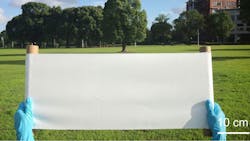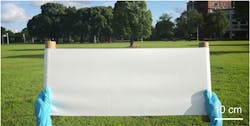Researchers at The University of Texas at Austin worked with their counterparts at Shanghai Jiao Tong University in China and KTH Royal Institute of Technology in Sweden to study a species of longicorn (aka longhorn) beetle that uses its wings to cool its body enough to survive in scorching hot climates near active volcanoes in Thailand and Indonesia, where summer temperatures frequently top 105°F (40°C), and the ground heats up to 158°F (70°C).
When it gets hot, the beetle remains still and stops foraging to avoid creating any excess heat from movement. Part of its ability to keep cool comes from its wings. They have triangular fluff on the top surface which are believed to reflect sunlight while helping shed internal body heat at the same time.
The international team decided to replicate the wings using common, low-cost materials that are mechanically strong and can be used to in high-volume assembly and processing machines. The goal was to devise a photonic film that passively cools.
The team made the working film out of polydimethylsiloxane (PDMS), a flexible, widely used polymer, along with ceramic particles. The materials are fairly common, and the film is made using a well-known process (micro-stamping) so the team believes the project will succeed where some other research efforts that tried to replicate biological organisms has failed.
The team came up with a film that reduces temperatures of items in sunlight by as much as 9°F (5.1°C) It does so passively, so it consumes no energy to carry out the cooling.
The film could be incorporated in coatings and put on a variety of objects to handle several tasks. On windows in office and apartment buildings it could reflect sunlight and lower air conditioning bills. On solar panels, it could protect the cells from being degraded by sunlight. Wrapped around parked cars and trucks, it could keep the interior and hardware cools in the summer. The cooling film could even be used in fabrics, wearables and personal electronic devices.
The U.S. Energy Information Administration projects a significant jump in air conditioning consumption by 2050—a 59% growth in the residential sector and a 17% increase in commercial use. As the need for more cooling rises, the film could meet the need for passive methods of cooling objects without consuming large amounts of energy or put a strain on the environment.
The researchers are trying to improve the manufacturing process for large-scale production. They will also seek commercialization opportunities in several areas, including energy-efficient buildings, water cooling, thermal fabrics, desert dew water harvesting and supplemental cooling systems for power plants.


